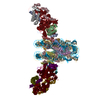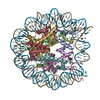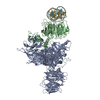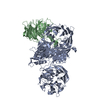+ Open data
Open data
- Basic information
Basic information
| Entry | Database: EMDB / ID: EMD-4766 | ||||||||||||||||||||||||
|---|---|---|---|---|---|---|---|---|---|---|---|---|---|---|---|---|---|---|---|---|---|---|---|---|---|
| Title | Cryo-EM structure of NCP-THF2(+1)-UV-DDB class B | ||||||||||||||||||||||||
 Map data Map data | |||||||||||||||||||||||||
 Sample Sample |
| ||||||||||||||||||||||||
 Keywords Keywords | DNA damage / Nucleosome / 6-4 photoproduct / DNA BINDING PROTEIN | ||||||||||||||||||||||||
| Function / homology |  Function and homology information Function and homology informationpositive regulation by virus of viral protein levels in host cell / spindle assembly involved in female meiosis / epigenetic programming in the zygotic pronuclei / UV-damage excision repair / biological process involved in interaction with symbiont / regulation of mitotic cell cycle phase transition / WD40-repeat domain binding / Cul4A-RING E3 ubiquitin ligase complex / Cul4-RING E3 ubiquitin ligase complex / Cul4B-RING E3 ubiquitin ligase complex ...positive regulation by virus of viral protein levels in host cell / spindle assembly involved in female meiosis / epigenetic programming in the zygotic pronuclei / UV-damage excision repair / biological process involved in interaction with symbiont / regulation of mitotic cell cycle phase transition / WD40-repeat domain binding / Cul4A-RING E3 ubiquitin ligase complex / Cul4-RING E3 ubiquitin ligase complex / Cul4B-RING E3 ubiquitin ligase complex / ubiquitin ligase complex scaffold activity / negative regulation of reproductive process / negative regulation of developmental process / cullin family protein binding / viral release from host cell / site of DNA damage / pyrimidine dimer repair / negative regulation of tumor necrosis factor-mediated signaling pathway / ectopic germ cell programmed cell death / positive regulation of viral genome replication / negative regulation of megakaryocyte differentiation / proteasomal protein catabolic process / protein localization to CENP-A containing chromatin / response to UV / Chromatin modifying enzymes / protein autoubiquitination / Replacement of protamines by nucleosomes in the male pronucleus / CENP-A containing nucleosome / Packaging Of Telomere Ends / Recognition and association of DNA glycosylase with site containing an affected purine / Cleavage of the damaged purine / positive regulation of gluconeogenesis / Deposition of new CENPA-containing nucleosomes at the centromere / Recognition and association of DNA glycosylase with site containing an affected pyrimidine / Cleavage of the damaged pyrimidine / telomere organization / Interleukin-7 signaling / Inhibition of DNA recombination at telomere / RNA Polymerase I Promoter Opening / Meiotic synapsis / Assembly of the ORC complex at the origin of replication / Regulation of endogenous retroelements by the Human Silencing Hub (HUSH) complex / SUMOylation of chromatin organization proteins / DNA methylation / Condensation of Prophase Chromosomes / epigenetic regulation of gene expression / Chromatin modifications during the maternal to zygotic transition (MZT) / SIRT1 negatively regulates rRNA expression / HCMV Late Events / Recognition of DNA damage by PCNA-containing replication complex / ERCC6 (CSB) and EHMT2 (G9a) positively regulate rRNA expression / innate immune response in mucosa / PRC2 methylates histones and DNA / Regulation of endogenous retroelements by KRAB-ZFP proteins / Defective pyroptosis / DNA Damage Recognition in GG-NER / nucleotide-excision repair / HDMs demethylate histones / Regulation of endogenous retroelements by Piwi-interacting RNAs (piRNAs) / HDACs deacetylate histones / TP53 Regulates Transcription of DNA Repair Genes / lipopolysaccharide binding / Nonhomologous End-Joining (NHEJ) / RNA Polymerase I Promoter Escape / Dual Incision in GG-NER / Transcription-Coupled Nucleotide Excision Repair (TC-NER) / Transcriptional regulation by small RNAs / Formation of TC-NER Pre-Incision Complex / Formation of the beta-catenin:TCF transactivating complex / Formation of Incision Complex in GG-NER / RUNX1 regulates genes involved in megakaryocyte differentiation and platelet function / Activated PKN1 stimulates transcription of AR (androgen receptor) regulated genes KLK2 and KLK3 / regulation of circadian rhythm / G2/M DNA damage checkpoint / Metalloprotease DUBs / NoRC negatively regulates rRNA expression / B-WICH complex positively regulates rRNA expression / DNA Damage/Telomere Stress Induced Senescence / Dual incision in TC-NER / PKMTs methylate histone lysines / Gap-filling DNA repair synthesis and ligation in TC-NER / Meiotic recombination / Pre-NOTCH Transcription and Translation / RMTs methylate histone arginines / Wnt signaling pathway / Activation of anterior HOX genes in hindbrain development during early embryogenesis / Transcriptional regulation of granulopoiesis / UCH proteinases / protein polyubiquitination / HCMV Early Events / positive regulation of protein catabolic process / antimicrobial humoral immune response mediated by antimicrobial peptide / cellular response to UV / structural constituent of chromatin / rhythmic process / cell junction / antibacterial humoral response / E3 ubiquitin ligases ubiquitinate target proteins / Recruitment and ATM-mediated phosphorylation of repair and signaling proteins at DNA double strand breaks / nucleosome Similarity search - Function | ||||||||||||||||||||||||
| Biological species |  Homo sapiens (human) Homo sapiens (human) | ||||||||||||||||||||||||
| Method | single particle reconstruction / cryo EM / Resolution: 4.8 Å | ||||||||||||||||||||||||
 Authors Authors | Matsumoto S / Cavadini S | ||||||||||||||||||||||||
| Funding support |  Switzerland, Switzerland,  Japan, 7 items Japan, 7 items
| ||||||||||||||||||||||||
 Citation Citation |  Journal: Nature / Year: 2019 Journal: Nature / Year: 2019Title: DNA damage detection in nucleosomes involves DNA register shifting. Authors: Syota Matsumoto / Simone Cavadini / Richard D Bunker / Ralph S Grand / Alessandro Potenza / Julius Rabl / Junpei Yamamoto / Andreas D Schenk / Dirk Schübeler / Shigenori Iwai / Kaoru ...Authors: Syota Matsumoto / Simone Cavadini / Richard D Bunker / Ralph S Grand / Alessandro Potenza / Julius Rabl / Junpei Yamamoto / Andreas D Schenk / Dirk Schübeler / Shigenori Iwai / Kaoru Sugasawa / Hitoshi Kurumizaka / Nicolas H Thomä /   Abstract: Access to DNA packaged in nucleosomes is critical for gene regulation, DNA replication and DNA repair. In humans, the UV-damaged DNA-binding protein (UV-DDB) complex detects UV-light-induced ...Access to DNA packaged in nucleosomes is critical for gene regulation, DNA replication and DNA repair. In humans, the UV-damaged DNA-binding protein (UV-DDB) complex detects UV-light-induced pyrimidine dimers throughout the genome; however, it remains unknown how these lesions are recognized in chromatin, in which nucleosomes restrict access to DNA. Here we report cryo-electron microscopy structures of UV-DDB bound to nucleosomes bearing a 6-4 pyrimidine-pyrimidone dimer or a DNA-damage mimic in various positions. We find that UV-DDB binds UV-damaged nucleosomes at lesions located in the solvent-facing minor groove without affecting the overall nucleosome architecture. In the case of buried lesions that face the histone core, UV-DDB changes the predominant translational register of the nucleosome and selectively binds the lesion in an accessible, exposed position. Our findings explain how UV-DDB detects occluded lesions in strongly positioned nucleosomes, and identify slide-assisted site exposure as a mechanism by which high-affinity DNA-binding proteins can access otherwise occluded sites in nucleosomal DNA. | ||||||||||||||||||||||||
| History |
|
- Structure visualization
Structure visualization
| Movie |
 Movie viewer Movie viewer |
|---|---|
| Structure viewer | EM map:  SurfView SurfView Molmil Molmil Jmol/JSmol Jmol/JSmol |
- Downloads & links
Downloads & links
-EMDB archive
| Map data |  emd_4766.map.gz emd_4766.map.gz | 93.5 MB |  EMDB map data format EMDB map data format | |
|---|---|---|---|---|
| Header (meta data) |  emd-4766-v30.xml emd-4766-v30.xml emd-4766.xml emd-4766.xml | 27.8 KB 27.8 KB | Display Display |  EMDB header EMDB header |
| Images |  emd_4766.png emd_4766.png | 147 KB | ||
| Filedesc metadata |  emd-4766.cif.gz emd-4766.cif.gz | 8.5 KB | ||
| Archive directory |  http://ftp.pdbj.org/pub/emdb/structures/EMD-4766 http://ftp.pdbj.org/pub/emdb/structures/EMD-4766 ftp://ftp.pdbj.org/pub/emdb/structures/EMD-4766 ftp://ftp.pdbj.org/pub/emdb/structures/EMD-4766 | HTTPS FTP |
-Validation report
| Summary document |  emd_4766_validation.pdf.gz emd_4766_validation.pdf.gz | 427.5 KB | Display |  EMDB validaton report EMDB validaton report |
|---|---|---|---|---|
| Full document |  emd_4766_full_validation.pdf.gz emd_4766_full_validation.pdf.gz | 427.1 KB | Display | |
| Data in XML |  emd_4766_validation.xml.gz emd_4766_validation.xml.gz | 6.2 KB | Display | |
| Data in CIF |  emd_4766_validation.cif.gz emd_4766_validation.cif.gz | 7.1 KB | Display | |
| Arichive directory |  https://ftp.pdbj.org/pub/emdb/validation_reports/EMD-4766 https://ftp.pdbj.org/pub/emdb/validation_reports/EMD-4766 ftp://ftp.pdbj.org/pub/emdb/validation_reports/EMD-4766 ftp://ftp.pdbj.org/pub/emdb/validation_reports/EMD-4766 | HTTPS FTP |
-Related structure data
| Related structure data |  6r92MC  4762C  4763C  4764C  4765C  4767C  4768C  6r8yC  6r8zC  6r90C  6r91C  6r93C  6r94C M: atomic model generated by this map C: citing same article ( |
|---|---|
| Similar structure data |
- Links
Links
| EMDB pages |  EMDB (EBI/PDBe) / EMDB (EBI/PDBe) /  EMDataResource EMDataResource |
|---|---|
| Related items in Molecule of the Month |
- Map
Map
| File |  Download / File: emd_4766.map.gz / Format: CCP4 / Size: 103 MB / Type: IMAGE STORED AS FLOATING POINT NUMBER (4 BYTES) Download / File: emd_4766.map.gz / Format: CCP4 / Size: 103 MB / Type: IMAGE STORED AS FLOATING POINT NUMBER (4 BYTES) | ||||||||||||||||||||||||||||||||||||||||||||||||||||||||||||||||||||
|---|---|---|---|---|---|---|---|---|---|---|---|---|---|---|---|---|---|---|---|---|---|---|---|---|---|---|---|---|---|---|---|---|---|---|---|---|---|---|---|---|---|---|---|---|---|---|---|---|---|---|---|---|---|---|---|---|---|---|---|---|---|---|---|---|---|---|---|---|---|
| Voxel size | X=Y=Z: 0.86 Å | ||||||||||||||||||||||||||||||||||||||||||||||||||||||||||||||||||||
| Density |
| ||||||||||||||||||||||||||||||||||||||||||||||||||||||||||||||||||||
| Symmetry | Space group: 1 | ||||||||||||||||||||||||||||||||||||||||||||||||||||||||||||||||||||
| Details | EMDB XML:
CCP4 map header:
| ||||||||||||||||||||||||||||||||||||||||||||||||||||||||||||||||||||
-Supplemental data
- Sample components
Sample components
+Entire : UV-DDB bound to a THF2 (+1) containing nucleosome class B
+Supramolecule #1: UV-DDB bound to a THF2 (+1) containing nucleosome class B
+Supramolecule #2: DNA
+Supramolecule #3: DNA damage-binding protein 1(2), DNA damage-binding protein 2
+Supramolecule #4: Histone H3.1, Histone H2A, Histone H2B
+Supramolecule #5: Histone H4
+Macromolecule #1: Human alpha-satellite DNA (145-MER)
+Macromolecule #2: Human alpha-satellite DNA (145-MER) with abasic sites at position...
+Macromolecule #3: DNA damage-binding protein 2
+Macromolecule #4: Histone H3.1
+Macromolecule #5: Histone H4
+Macromolecule #6: Histone H2A type 1-B/E
+Macromolecule #7: Histone H2B type 1-J
+Macromolecule #8: DNA damage-binding protein 1,DNA damage-binding protein 1
-Experimental details
-Structure determination
| Method | cryo EM |
|---|---|
 Processing Processing | single particle reconstruction |
| Aggregation state | particle |
- Sample preparation
Sample preparation
| Concentration | 2 mg/mL |
|---|---|
| Buffer | pH: 7.4 |
| Vitrification | Cryogen name: ETHANE / Chamber humidity: 85 % / Chamber temperature: 277 K / Instrument: LEICA EM GP |
- Electron microscopy
Electron microscopy
| Microscope | FEI TITAN KRIOS |
|---|---|
| Image recording | Film or detector model: GATAN K2 SUMMIT (4k x 4k) / Detector mode: COUNTING / Average electron dose: 40.0 e/Å2 |
| Electron beam | Acceleration voltage: 300 kV / Electron source:  FIELD EMISSION GUN FIELD EMISSION GUN |
| Electron optics | Illumination mode: SPOT SCAN / Imaging mode: BRIGHT FIELD |
| Experimental equipment |  Model: Titan Krios / Image courtesy: FEI Company |
- Image processing
Image processing
| Startup model | Type of model: OTHER |
|---|---|
| Final reconstruction | Resolution.type: BY AUTHOR / Resolution: 4.8 Å / Resolution method: FSC 0.143 CUT-OFF / Software - Name: RELION (ver. 2) / Number images used: 48925 |
| Initial angle assignment | Type: OTHER |
| Final angle assignment | Type: OTHER |
-Atomic model buiding 1
| Initial model |
| ||||||||||||||||||||||||||
|---|---|---|---|---|---|---|---|---|---|---|---|---|---|---|---|---|---|---|---|---|---|---|---|---|---|---|---|
| Refinement | Space: REAL / Protocol: FLEXIBLE FIT / Target criteria: Cross-correlation coefficient | ||||||||||||||||||||||||||
| Output model |  PDB-6r92: |
 Movie
Movie Controller
Controller



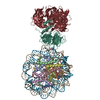

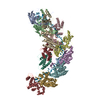



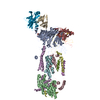


















 Trichoplusia ni (cabbage looper)
Trichoplusia ni (cabbage looper)
